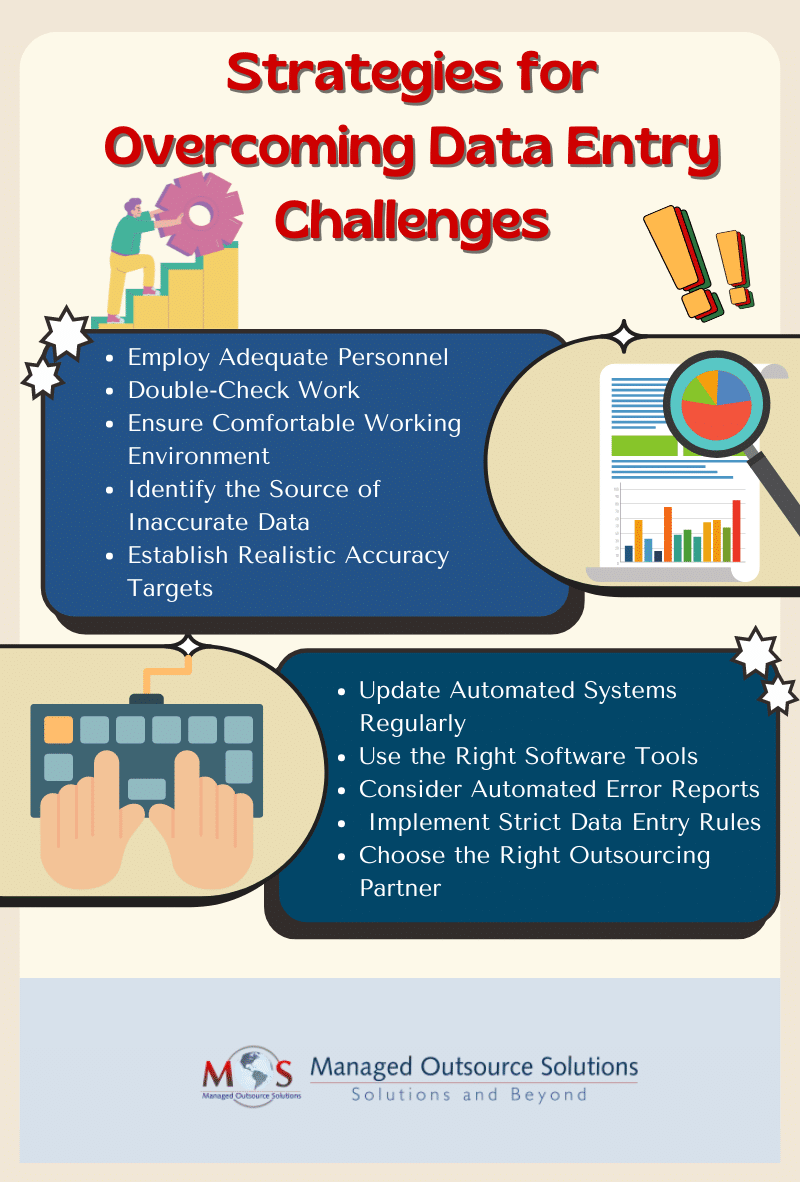In healthcare, finance, or any other business field, data entry is essential to maintain accurate and up to date records. However, there are several challenges involved that might result in mistakes, inefficiencies, and higher expenses. Leveraging data entry services can help mitigate these challenges, but understanding the core issues is the first step in resolving them.
Businesses often get to a point where internal data management becomes too much to handle as they grow and their needs for data processing increase. Accurately capturing all types of incoming documents, including purchase orders, invoices, catalogs, and feedback forms, is essential. For additional processing and use, all pertinent data from these documents must be entered into software programs, Excel sheets, ERP programs, or cloud-based apps. This is when it gets harder to maintain strict security protocols and more mistakes might happen, especially if human data entry is done internally. That’s why it’s preferable to outsource data input to a trustworthy service provider.
Common Challenges of Manual Data Entry
- Human Error: One of the most common problems with data entry is human error. Errors including typos, improper data formatting, and misreading of information can happen, particularly when handling massive amounts of data by hand. These mistakes may result in erroneous records, which can have a big impact on the effectiveness of operations and decision-making. Human mistakes can be reduced by putting in place checks and balances such as automated error detection and double-entry verification.
- Data Inconsistency: When data is submitted into multiple departments or systems using disparate formats or standards, data inconsistency occurs. Data analysis and reporting can become more difficult as a result of inconsistencies and faulty data. This problem can be mitigated by standardizing data entry procedures and using consistent templates, which will guarantee that all data is captured reliably, regardless of the source.
- Data Insecurity: Keeping data secure is a difficult task, especially when dealing with sensitive data. Insufficient security protocols used during the data entering phase may result in compromised data, unapproved access, and misplacement of private data. To safeguard data integrity and uphold compliance with data protection laws, strong security measures including encryption, access controls, and secure data entry methods must be put in place.
- High Costs: It can be expensive to maintain an in-house data entry crew, especially when you include costs for infrastructure, software, training, and staff wages. For many firms, data entry is an expensive undertaking because of these rapidly mounting expenses. Employing specialist service providers to handle data entry work can be an affordable way for businesses to handle their data requirements without having to pay for an internal crew.
- Managing Huge Volume of Data: As businesses grow, so does the volume of data they must manage. Handling large volumes of data can quickly become overwhelming, leading to backlogs, delayed processing, and difficulty in maintaining data accuracy. Effective data management strategies, such as implementing automated processing tools and regularly archiving outdated data, are essential to keep data entry tasks manageable and ensure that critical information is processed in a timely manner.
Tips to Resolve Data Entry Challenges
- Employ Enough Personnel: No matter how productive your staff is, when they are overworked, mistakes are bound to happen. One of the main issues with manual data entry is this. Employees that are overworked, anxious, and tired will quickly get resentful of their jobs and make thoughtless mistakes. So, it’s critical to make sure you have enough employees to handle the demand.
- Make Sure To Double-Check The Work: One of the best ways to overcome challenges with manual data input is to have a standard operating procedure that allows you to verify that all data entry work is completed. Due to the tedious nature of data re-entry, the majority of managers and supervisors frequently consider “how to avoid data re-entry”. Reducing errors and doing frequent checks, if feasible, will help to do away with the requirement for data re-entry.
- Create a Comfortable Working Environment: For workers to complete their work effectively, they need to be in a comfortable working atmosphere. Dull and repetitive chores can cause inattention, which leads to mistakes. Erroneous data entry may occur due to weariness from typing and persistent eye strain. Thus, everything matters, from making sure staff workstations have the proper ergonomic support to making sure there are enough breaks.
- Find the Source of Inaccurate Data: The most effective method of closing the gap is to determine the internal and external sources of inaccurate data. There must be a mechanism in place to guarantee that everything is checked and updated, from recognizing inaccurate numbers to examining the transfer of data between many databases and updating the time-bound modifications. The quick fix for data accuracy issues will come from identifying its root cause.
- Establish Reasonable Accuracy Targets: Data input accuracy will increase if reasonable targets are set. As a result, management can actively create goals that are clear and attainable for the whole data entry crew. Subsequently, the group can be assessed according to how well the data was entered, captured, and coded.
- Update the Automated Systems on Time: If your company harvests data automatically, you must understand that even systems might make mistakes. When their programs are not updated on a regular basis, this occurs. Therefore, it’s crucial to make sure that all automated systems are safe from viruses and malware, updated on time, and functioning properly.
- Use the Right Software Tools: Data entry operators’ burden can be reduced by utilizing Intelligent Character Recognition (ICR) and Optical Character Recognition (OCR). Data extraction is automatic with this kind of software. Errors are simply reduced when typing less.
- Consider Automated Error Reports: One characteristic of sophisticated software that can be used to assess the effectiveness of data entry is automated error reports. Making sensible use of this will aid in lowering errors. This is crucial when entering comparable data for a particular project. An individual’s social security number, for example, consists of nine digits. The software will automatically notify the staff if an operator types less numbers than required by detecting that error.
- Maintain Strict Guidelines for Accurate Data Entry: Adopting strict criteria for data entry correctness will guarantee that your data improves in quality and complies with all pre-established requirements, such as data profiling, geo-coding, linking, matching, and routine data monitoring.
- Pick the Right Outsourcing Partner: Outsourcing data entry could be the ideal solution if you’re still wondering “how to prevent data entry errors” because it’s a tedious and repeated process. Your data entry requirements can be effectively handled by outsourcing service providers, that also possess the necessary resources. To guarantee accurate data entry, it is crucial in this instance that the service provider takes all of the aforementioned precautions.
While data entry comes with its challenges, they are not insurmountable. By understanding these challenges and implementing targeted solutions, businesses can improve the accuracy, efficiency, and security of their data entry processes. Outsourcing to data entry services can further alleviate these challenges, providing expert support to ensure that data is handled with the utmost care and precision.





